Disclosure: Meeple Mountain received a free copy of this product in exchange for an honest, unbiased review. This review is not intended to be an endorsement.
Blessed are the Peacemakers…or do you want to be Lord of Harrenhal?
Risk is one of my guilty pleasures as a Christian pacifist. Scheming, war, and violence are bad things! BUT I love the aspects of playing a war game. Using tactics, strategy, and manipulative diplomacy/propaganda to conquer the entire world through a series of roughly simulated battles gives me joy. So when I saw a request for reviews of a game titled Dawn of Peacemakers, my interest was piqued. Upon quickly purviewing the Kickstarter page, I thought to myself, “oh this is great, a game about stopping two warring factions. Blessed are the peacemakers, indeed!”

Upon close inspection, I found the game to be less Lord Jesus and more Lord Petyr Baelish (Littlefinger from Game of Thrones – a manipulative schemer). Not a discouragement, just a mental resynchronization. To win each of the main campaign’s scenarios, you want to make both armies retreat simultaneously. Instead of controlling the armies, up to four players each control an adventurer traveling around the battlefield attempting to manipulate, scheme, and undermine both armies until they each give up in frustration and despair. There’s also a skirmish game where you directly control an army battling against another player. This mode does not contain adventurers.
“I would name you the Hand of the King”
Spoiler-Free Summary
Dawn of Peacemakers has a lot of hidden content and while I don’t intend to get into big spoilers, I think my thoughts include enough spoiler discussion that a few of you may wish to stop reading after the next paragraph.
Overall, Dawn of Peacemakers ends up being a mish mash of many other games that can consume hours of gaming per scenario. It has ticking time bomb deck of cards like Pandemic’s epidemics, miniature tactics manipulation, and a campaign (but not legacy) style of storytelling that is becoming more common in contemporary gaming, This game is probably most enjoyable if you have at least a friend or two, plenty of time, and really like puzzle solving. You may also like it if you are really into the world of Daimyria, a mirror universe of our world with animalfolk. The world of Daimyria was first introduced in the Dale of Merchants series of deck building games.

“I serve the realm, and the realm needs peace.”
Minor Spoilers Included
There are arguably 2.5 games under the title of Dawn of Peacemakers. There’s a fully cooperative campaign of 12 scenarios, there’s a semi-cooperative campaign beginning somewhere in middle of the fully co-op campaign, and there’s a skirmish mode where you actually do control one army each and battle it out with another player. I managed to play 5 scenarios, including solo and fully cooperative two player with three different partners, and played the first scenario twice. This review will focus on the fully cooperative campaign, but will also touch on the others.
The Campaign
Winter is Coming
General Setup
In campaign mode, 1-4 players each select an adventurer represented by its own miniature. Each adventurer has her own backstory to read, but there are no gameplay differences. The board is set up with various hexed tiles detailed on the starting page of each scenario. Units and their order groupings are also designated on these tiles via icons. The number of unit types can be confirmed at the end of a chart that also specifies which cards to place into the order decks for each army. Each army has two order decks: a ploy deck and a task deck. These are the cards used to instruct the army on which units get to act, how they act, whether these acts are modified with various tweaks. Each scenario informs you of any new concepts and instructs you to pull out new cards to help form decks or represent unit types.
There’s also a resource deck; the main one for adventurer actions. All actions that adventurers can perform arise from the resource cards; without resource cards, adventurers can’t act. Players begin the game with 2 resource cards each and receive a varying number of resource cards at the end of her turn depending on the number of players and turn order.
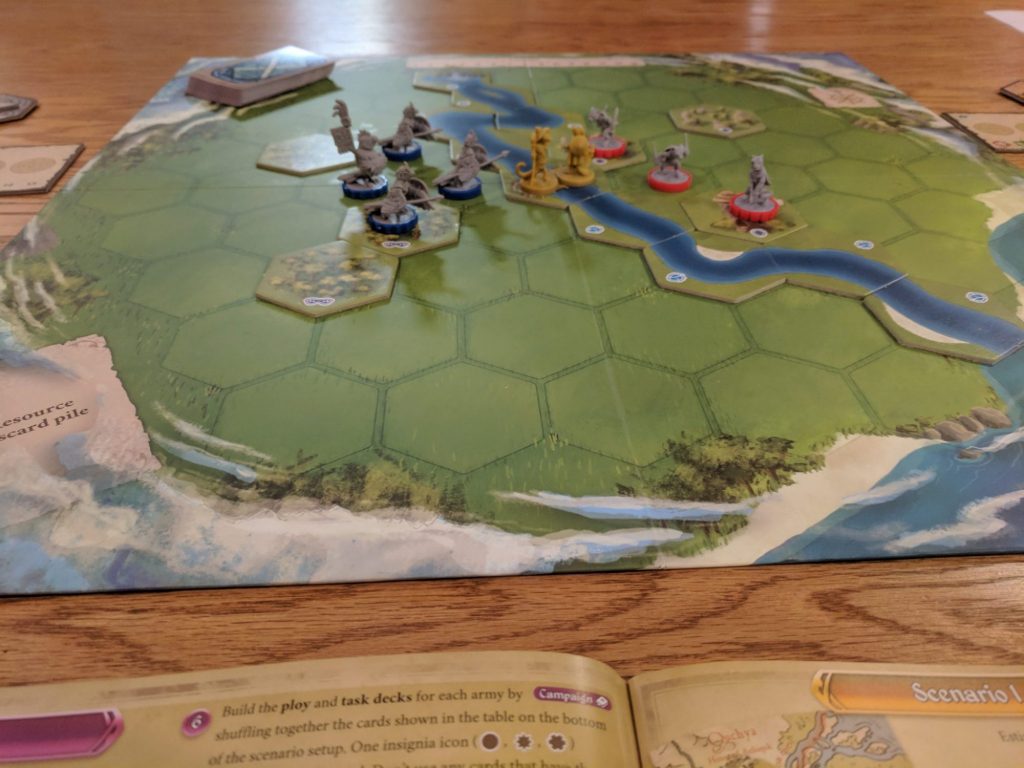
The War of the Five Kings
Gameplay
Each round consists of an Adventurer Phase, an Army Phase, and a Status phase. During the Adventurer phase, each player takes a turn, with turn order rotating each round. Each adventurer can take as many actions as his resources allow during his turn. Players select a card from their hand and announce which of the four resources they will use from it. The various resources are:
- influence – used to look at and manipulate the order decks of armies,
- movement points – used to move the adventurer around the board,
- fortifications – used to help the defense of various army units on specified hexes, and
- schemes – used to do things like a manipulate the order decks without meeting influence requirements, covertly sabotage an army unit, change various status and traits of units.
At the end of his turn, the player draws more resource cards. I find that the schemes are very alluring to players, but the most important strategic usage of cards is for their influence to manipulate the order decks. The bulk of the game is deck manipulation of the army order decks. To this end, when a player chooses to use influence to look at a army order deck, other players may also chip in their own influence cards to allow that player to look at more cards.
During the Army phase, a card is flipped from every army deck and all armies act simultaneously. Some orders change the speed, some are for movement, some for attack, and some for extra defense. Each of the ploy decks typically contain two “Revoked” cards which cancel that army’s action for the round and also reduces their motivation by one. This operates as a timer; if you do nothing to prevent those cards from appearing, they will reduce motivation regularly within a shuffle.
In the Status phase, you check each army’s motivation. If that motivation has been moved down to 1 or 2, it is ready to withdraw. When all armies are ready to withdraw, the game is over, usually successfully since that is one of the main objectives for each scenario. If an army has been reduced to 0 motivation, that army surrenders and the other side has won and the players have failed. If both sides surrender because both hit 0 motivation simultaneously, the scenario is considered to be an utter failure for the adventurers. Thus, while Revoked cards can be useful, unchecked Revoked cards can bring you early failure. The various armies usually start with lopsided motivation. During some of my games, I focused on reducing the motivation of the stronger side, only to find that I had neglected the other side too long and could not recover fast enough to prevent catastrophe.
If game end conditions have not been met, a new round begins.
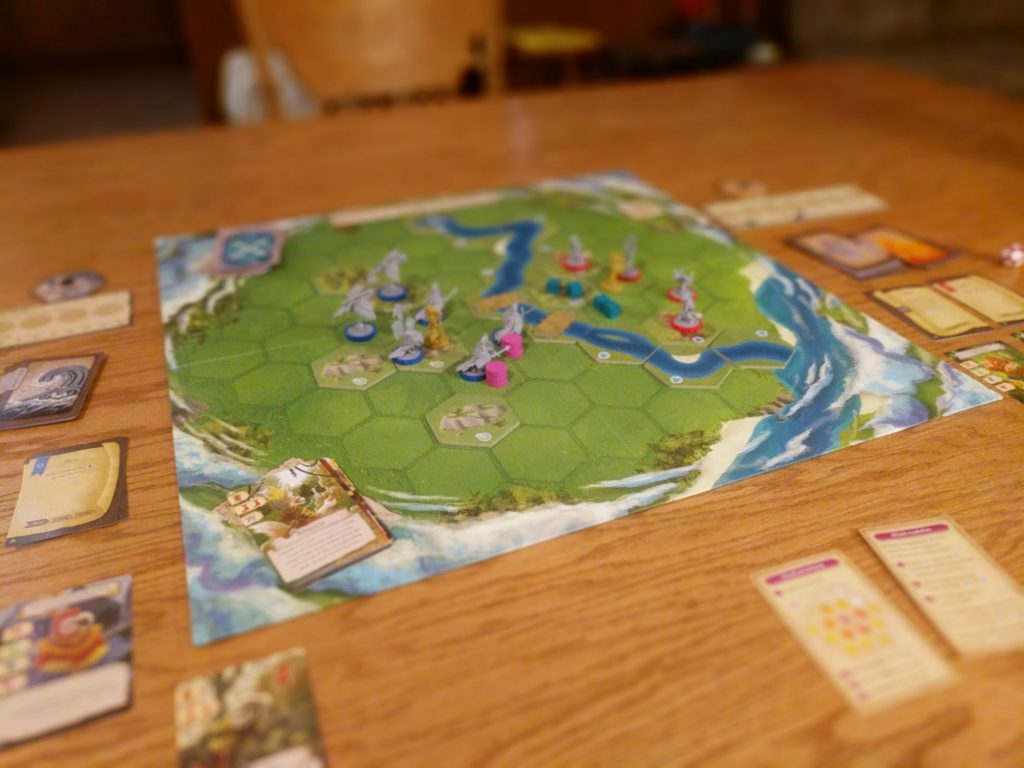
“The girl is as clever as she is pretty”
Artwork
I find the artwork to be exceptional. It looks beautiful and adds a lot of atmosphere to the game. In most places, the iconography aids in gameplay. I have only two criticisms, and one is silly. First is the group symbols. Army units are broken up into groups symbolized by circles, gears, and stars. The gears and stars are hard to distinguish in low light conditions or from a distance. I would like to see a future printing reduce the star to a 4 ray star. This could be implemented in both the physical base ring pieces which are swapped out on the miniatures and in the manual. The second criticism is that the animal eyes creep me out.

Would Sam the Slayer read it?
Story
Grain of salt warning: I don’t usually play games for the story. I read novels. I love to have a good theme so I can tell my own story while I play games, but I don’t generally desire a lot of plotted out story in my board games. That being said, what bits of the story I read felt well written and thought out. It is clear that the writers put forth a lot of effort in the coordination of the story and scenarios. Due to time, I was unable to finish the entire progression of the story, so I peeked ahead to the last scenario’s endings. Personally, I felt disappointed in the way Snowdale Design chose to handle the challenges of designing a multiple ending prequel. I feel that it would have been stronger if the game deviated from the self-inposed canon for the sake of the game. Regardless, I think Daimyria fans will appreciate the additional lore while playing Dale of Merchants.
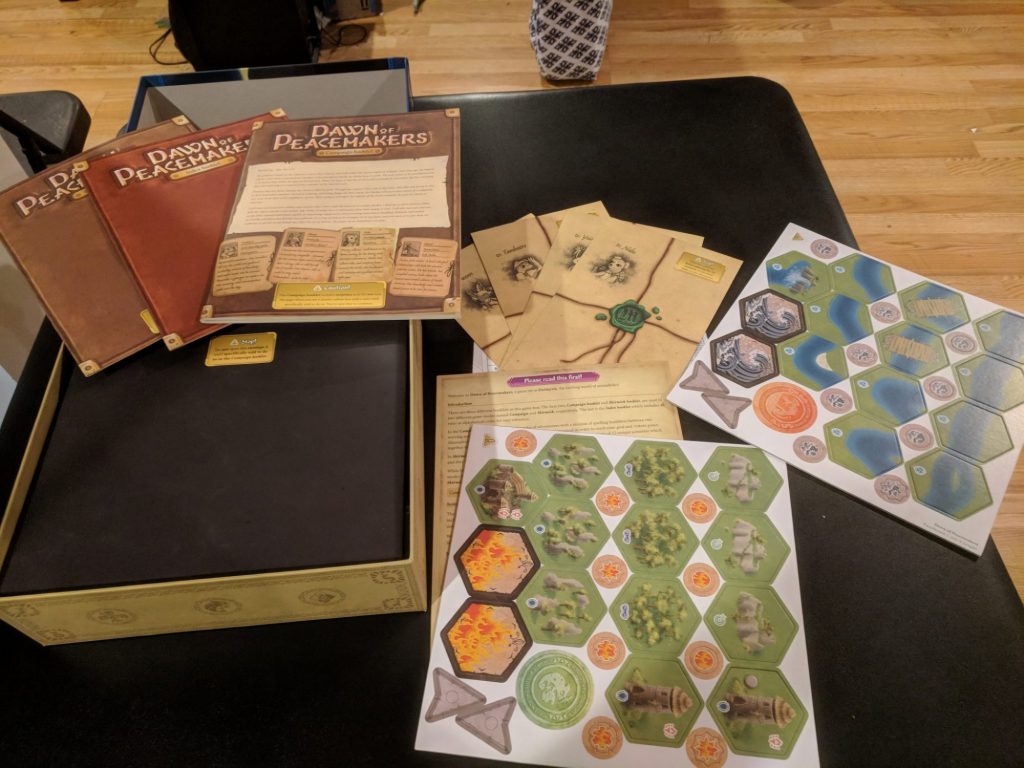
“Why is it always the innocents who suffer most, when you high lords play your game of thrones?”
Final Campaign Thoughts
Dawn of Peacemakers’ campaign mode is a game with a similar underlying structure to Pandemic, focusing on deck manipulation. Like Pandemic, there’s a board where various things are happening and you need to deal with them, but ultimately, there’s multiple decks of cards that dictate and maintain the pace of the game. Ignore those decks and you’ll fail.
Due to the artwork issue mentioned earlier and the number of components, setup can take quite a while. The manual lists estimated playing times which I find to be sufficiently accurate if it’s not including the setup time. The first scenario is around 30-60 minutes. The longest scenario estimate is 160 minutes for the 12th and final scenario. To play all 12 sessions, you’re looking north of 12 hours at the minimum estimates.
Another potential snag to be aware of are the rules. The game attempts to start out with a smaller subset of rules and build on them during each scenario. I found the number of rules to be quite a bit to juggle and not all of them were intuitive. Army units have a welcomed rigid and laid out set of rules governing their movement, but picking the right target is not easy and involves a fair amount of mental balancing. There are other rules that are part of one-time scenarios that also fell on the ambiguous side of interpretation. I disagreed with a fellow player as to more than one rule and neither of us had a game fueled motive for the other to be wrong.
I mentioned earlier about a semi-cooperative mode. Midway through the campaign, the players are given an option to continue playing fully cooperative or they can play with personal agendas. The personal agendas can cause one player/adventurer to become a traitor. I never tried this aspect out as I didn’t have more than two players and felt it would be a bit much for a 2 player session. I imagine this could be a thrilling aspect of the campaign if you have a consistent group of 4 to play. For the fully cooperative mode, I think the game will play about the same from 2-4 players.
I Demand Trial by Combat!
Skirmish Mode
The game recommends you play the campaign mode before playing the skirmish mode. Based on this recommendation, I expected a mode of dueling campaigns. Imagine two people playing Pandemic, but competing to see who could eradicate their disease first. Instead, skirmish mode is an entirely different game utilizing the same components minus the resource deck. Like the campaign, there are various scenarios to dictate the setup. If you play through the various skirmishes before playing through the campaign mode, you will encounter campaign spoilers.
In skirmish mode, there’s a drafting phase where you build your hand from the army order cards and buy units. Then, you play orders to directly control your army in your quest to defeat the other side. Adventurers are not used. I recommend viewing it as a completely different game with a lot of potential. Enough potential that this review should not be considered a review of that mode at all.
Winter has Arrived
Conclusion
Ultimately, I didn’t find this game to be my cup of tea. That’s not to say it will sit on the shelf unused, at least one of the players I played with said they would play it again after two non-sequential sessions. I simply have too many other games competing with it. A good way of looking at Dawn of Peacemakers is that you are getting two games in one box. If you like both, that’s a great value. If you like only one, it’s still a good value with an extra you can ignore.
Final note: I would gladly give it another go if it arrived in digital form. It would feel more at home there and would solve some of the problems I observed. It already has a video game aesthetic to it in the fashioning of the rules, some of it’s gameplay, and artwork. Setup time would be non-existent, the fiddly, tedious rule divining for handling the Army phase would be reserved only for figuring out your strategy. As a whole, the game would operate faster. I think ultimately, it would feel like playing the original Warcraft II story mode— and that’s a good thing in my book.


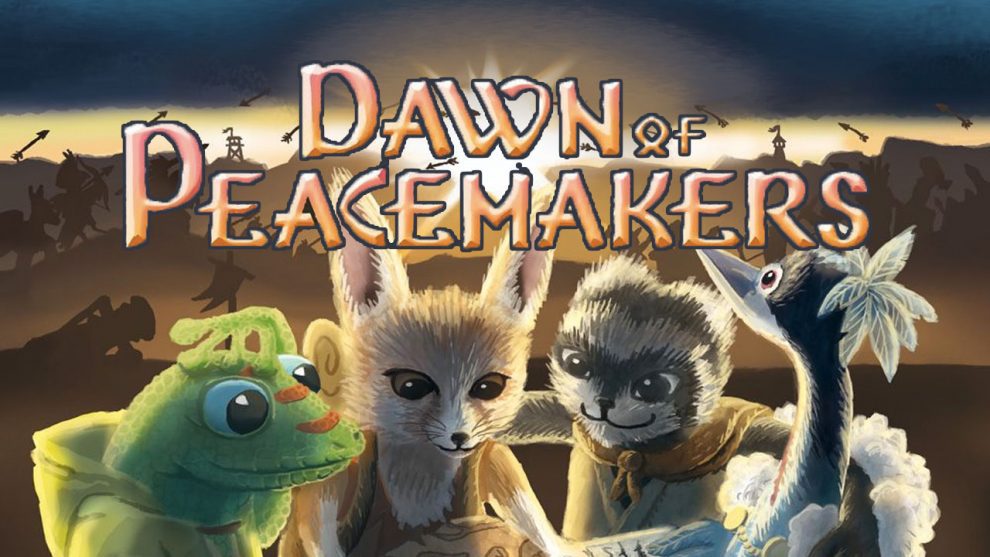

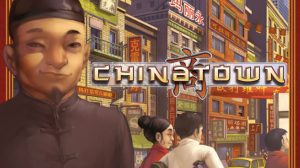






Add Comment